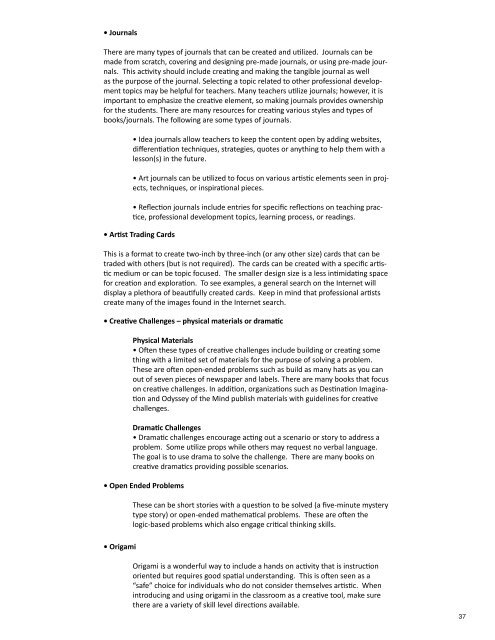Torrance Journal for Applied Creativity
TorranceJournal_V1
TorranceJournal_V1
Create successful ePaper yourself
Turn your PDF publications into a flip-book with our unique Google optimized e-Paper software.
• <strong>Journal</strong>s<br />
There are many types of journals that can be created and utilized. <strong>Journal</strong>s can be<br />
made from scratch, covering and designing pre-made journals, or using pre-made journals.<br />
This activity should include creating and making the tangible journal as well<br />
as the purpose of the journal. Selecting a topic related to other professional development<br />
topics may be helpful <strong>for</strong> teachers. Many teachers utilize journals; however, it is<br />
important to emphasize the creative element, so making journals provides ownership<br />
<strong>for</strong> the students. There are many resources <strong>for</strong> creating various styles and types of<br />
books/journals. The following are some types of journals.<br />
• Idea journals allow teachers to keep the content open by adding websites,<br />
differentiation techniques, strategies, quotes or anything to help them with a<br />
lesson(s) in the future.<br />
• Art journals can be utilized to focus on various artistic elements seen in projects,<br />
techniques, or inspirational pieces.<br />
• Reflection journals include entries <strong>for</strong> specific reflections on teaching practice,<br />
professional development topics, learning process, or readings.<br />
• Artist Trading Cards<br />
This is a <strong>for</strong>mat to create two-inch by three-inch (or any other size) cards that can be<br />
traded with others (but is not required). The cards can be created with a specific artistic<br />
medium or can be topic focused. The smaller design size is a less intimidating space<br />
<strong>for</strong> creation and exploration. To see examples, a general search on the Internet will<br />
display a plethora of beautifully created cards. Keep in mind that professional artists<br />
create many of the images found in the Internet search.<br />
• Creative Challenges – physical materials or dramatic<br />
Physical Materials<br />
• Often these types of creative challenges include building or creating some<br />
thing with a limited set of materials <strong>for</strong> the purpose of solving a problem.<br />
These are often open-ended problems such as build as many hats as you can<br />
out of seven pieces of newspaper and labels. There are many books that focus<br />
on creative challenges. In addition, organizations such as Destination Imagination<br />
and Odyssey of the Mind publish materials with guidelines <strong>for</strong> creative<br />
challenges.<br />
Dramatic Challenges<br />
• Dramatic challenges encourage acting out a scenario or story to address a<br />
problem. Some utilize props while others may request no verbal language.<br />
The goal is to use drama to solve the challenge. There are many books on<br />
creative dramatics providing possible scenarios.<br />
• Open Ended Problems<br />
These can be short stories with a question to be solved (a five-minute mystery<br />
type story) or open-ended mathematical problems. These are often the<br />
logic-based problems which also engage critical thinking skills.<br />
• Origami<br />
Origami is a wonderful way to include a hands on activity that is instruction<br />
oriented but requires good spatial understanding. This is often seen as a<br />
“safe” choice <strong>for</strong> individuals who do not consider themselves artistic. When<br />
introducing and using origami in the classroom as a creative tool, make sure<br />
there are a variety of skill level directions available.<br />
37


